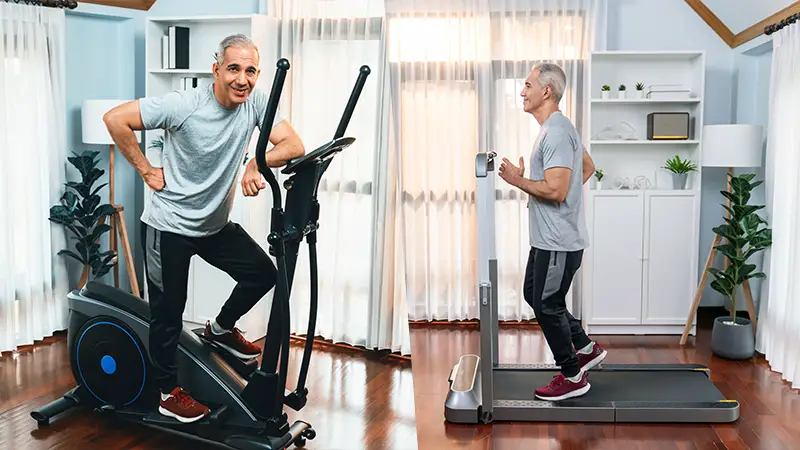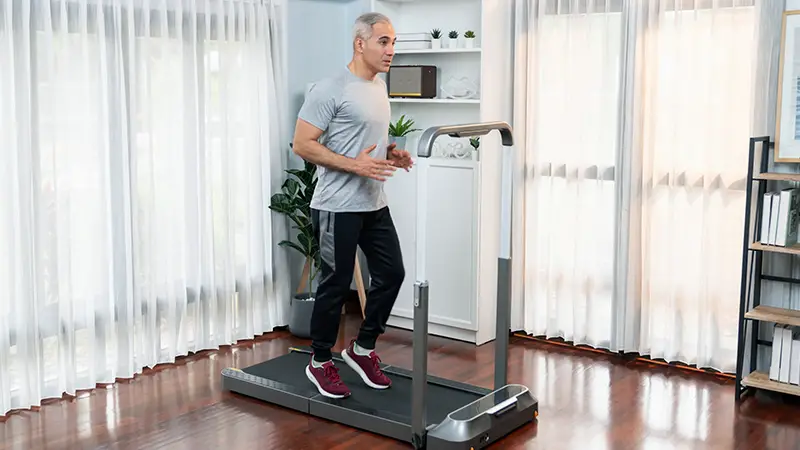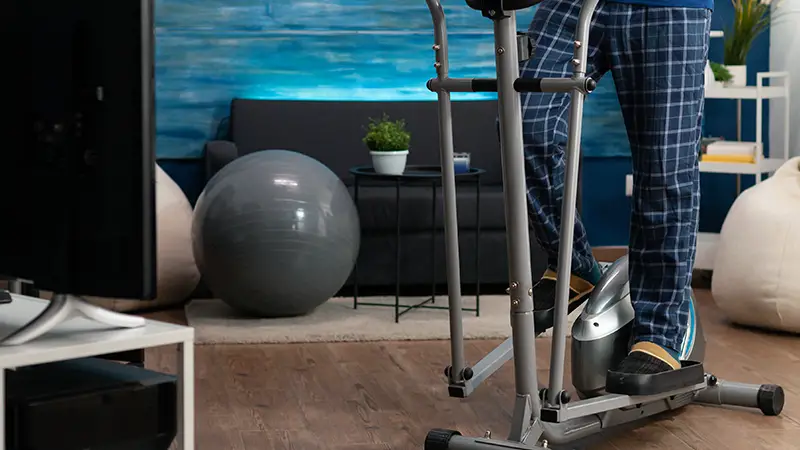Navigating the world of cardio equipment can be a daunting task, especially when the options are as diverse as treadmills and elliptical machines. Both offer unique benefits, but which one is the best for seniors?
Treadmills and ellipticals are both capable of delivering high-calorie workouts, but the actual burn depends on factors like intensity, duration, and your body weight.
Treadmills, with their high inclines, can ramp up calorie burning, but ellipticals offer a low-impact alternative, reducing stress on your knees, hips, and back.
Choosing the right cardio exercise isn’t just about calorie burn though. It’s about considering your fitness goals, health constraints, and even practical aspects like space and budget. So, let’s dive in and explore which machine could be your perfect match.

Understanding Treadmills
For seniors, choosing the most suitable cardio machine requires adequate knowledge about its functioning, benefits, and potential drawbacks.
A treadmill can be an attractive option, offering a versatile and natural cardio workout. The following discussion lays out the pros and cons of using a treadmill.
Pros of Using a Treadmill

- Easy to Use: Treadmills are relatively easy to use, with a predictable surface that reduces the risk of tripping compared to sidewalks or trails.
- Controllable Workout: All aspects of the workout can be controlled by the user, including speed, incline, warm-up and cool-down periods, and energy expenditure. Users can also design custom programs to fit their time constraints.
- Multiple Users: Multiple users can use the same equipment without adjusting the structure, making it a convenient option for households with multiple exercisers.
- Tracking Fitness Progress: Some treadmills have special features such as step counters and heart rate monitors, allowing users to track their fitness progress.
- Calorie Burn: Running on a treadmill generally burns calories faster than most other forms of in-home exercise, such as biking
Cons of Using a Treadmill
- Boredom: One of the biggest hurdles to running on the treadmill is the boredom that many people face.
- Lack of Downhill Option: Most treadmills don’t have a downhill option. Downhill running requires greater eccentric contraction of the quadriceps and lower leg muscles and is a skill. If you don’t do it regularly, you’ll likely find yourself with an inefficient stride when running downhill.
- No Fresh Air: The large majority of amateur athletes spend the bulk of their time inside working and sleeping. If you add training to that, likely, you’re rarely outside. Running on a treadmill doesn’t provide the benefits of nature and fresh air.
- Limited Exercise Variety: Treadmills provide a limited kind of exercise – walking to running. Some people find treadmills boring after a while.
- Maintenance and Repair Challenges: Treadmills require regular maintenance and can be difficult or near impossible to repair on your own, often requiring you to hire a trained professional if yours breaks down.
Understanding Ellipticals
Ellipticals, as a form of exercise equipment, cater to a variety of workout needs. They blend lower-body pedalling and upper-body resistance, thus encompassing multiple muscle groups in one workout session. Let’s dive into the pros and cons of using an elliptical, especially for seniors.
Pros of Using an Elliptical

- Low-Impact Exercise: Ellipticals stand out for their low-impact exercise capability. Unlike treadmills, they allow your feet to remain stationary, reducing the stress on your joints, a factor crucial for seniors with joint issues.
- Full Body Workout: With the blend of pedalling and upper-body resistance, ellipticals target multiple muscle groups, facilitating a comprehensive workout.
- Calorie Burn Potential: While the precise calorie burn varies based on the workout intensity, ellipticals have a high calorie burn potential, aiding in effective weight management.
- Variable Intensity: Just as treadmills adjust for speed and incline, most ellipticals offer resistance and incline settings for a customizable workout schema.
- Adaptability Challenges: The motion of an elliptical can take some time to get accustomed to, especially for beginners or those transitioning from different types of cardio equipment.
- Lower Bone Density Benefit: Unlike weight-bearing exercises like walking or running, ellipticals may not provide as much benefit in terms of improving bone density, a concern for many seniors.
- Safety Concerns: Despite being low-impact, ellipticals can pose safety issues for those with balance issues or certain musculoskeletal conditions.
Remember to seek medical clearance before starting an exercise program. It is essential to find the right machine fitting your individual needs and conditions. Exploring both pros and cons of ellipticals helps you make an informed decision.
Considerations for Choosing Between Treadmill and Elliptical
Personal Fitness Goals
Different exercise machines cater to distinct fitness objectives. For those aiming to simulate the feel of running, treadmills provide an ideal platform.
They offer adjustable speed and incline settings, enhancing the intensity of your workout. Conversely, ellipticals offer lower-body pedalling mixed with upper-body resistance for a full-body exercise suitable for weight loss or muscle toning.
Joint Health Concerns
Joint integrity is a critical factor when choosing your exercise equipment. Studies suggest that ellipticals reduce joint stress, making them beneficial for those with osteoarthritis.
On the contrary, treadmills, despite their shock absorption feature, involve impact which could potentially be stressful to joints, particularly at higher speed or incline levels.
Variety in Workouts and Motivation
The element of interest determines your commitment to a regular workout routine. Treadmills offer a range of walking, jogging, and running options, keeping your workout routine versatile.
Ellipticals, apart from regular forward motion, allow for backward pedalling, providing variation and targeting different muscle groups.
Space and Budget
Financial limitations and physical constraints play a compelling role when choosing between a treadmill and an elliptical.
Treadmills often require more space but can fold away for storage. They usually have a wider range of prices. Ellipticals, on the other hand, occupy a fixed space and typically fall into a more uniform price bracket.
Addressing Specific Needs: Recovery, Race Training, Full Body Workout, Weight Loss
The choice of cardio equipment depends on individual health needs. Ellipticals are beneficial for patients recovering from injuries or with joint issues due to their low-impact, full-body exercise, while treadmills are suitable for race training.
Both machines can aid in weight loss through intense workouts. However, the best exercise machine varies according to personal fitness goals, preferences, and physical condition.
Consultation with healthcare professionals is essential before starting a new exercise program or using new equipment.
Effectiveness of Treadmill vs Elliptical

As it comes to maintaining overall fitness, the effectiveness of the chosen exercise equipment plays a prominent role, not just for you but also for many other senior individuals.
Now, let’s break down the operational effectiveness of both elliptical machines and treadmills from the angles of calorie burn, joint impact, usability for beginners, and overall fitness impact.
Calorie Burn Count: Treadmill vs Elliptical
The burning of calories ties directly to the physical intensity of your exercise. Both treadmill and elliptical workouts present the potential for a high-calorie burning workout.
The extent to which you can burn calories depends on several factors, namely intensity, duration, and your body weight.
As an instance, increasing the incline on a treadmill requires more energy, thus augmenting the calorie-burning potential. Similarly, ellipticals can provide a substantial calorie burn, especially if you utilize the resistance and arm involvement to engage your whole body.
Impact on Joints: Treadmill vs Elliptical
Provisions for minimizing joint wear and tear rank high for seniors dealing with joint pain or osteoporosis. Running on a treadmill can amplify the risk of injury, particularly in comparison to lower-impact exercises like elliptical training.
No doubt, treadmill activities stimulate bone-strengthening, yet the risk of potential injury might overshadow its benefits.
On the other hand, elliptical machines permit your feet to stay stationary on the pedals, cutting down the stress on your knees, hips, and back, thus proving to be a safer alternative.
Usability for Beginners: Treadmill vs Elliptical
Most beginners gravitate towards treadmills, simply because walking or running is something everyone intuitively knows.
However, with the availability of handles and the ability to alternate pedaling forwards and backwards on ellipticals, beginners can soon adapt to this equipment. The elliptical also offers the prospect of an upper body workout, further enhancing the overall usability.
Overall Fitness Impact: Treadmill vs Elliptical
Taking into account the overall fitness impact, both the treadmill and the elliptical can be customized to your fitness level, goals and needs. Cardiovascular strengthening is an evident benefit of using either machine.
Specifically, treadmill running proves more beneficial if you’re gearing up for a race, as it directly nurtures your running efficiency. For a comprehensive workout involving your whole body, the elliptical machine stands out as an ideal choice.
Remember, whichever machine you select, it’s about balancing out your specific fitness objectives, personal health restrictions, space availability, and financial limitations.
Both treadmill and elliptical workouts offer their unique advantages. Thus, it’s all about customizing based on what works best for your circumstances.
Overcoming Space Constraints
When considering an at-home cardio routine for seniors, it’s essential to look into how well your chosen fitness equipment fits into your available space.
Treadmills and ellipticals come in different sizes, and some offer features that help you maximize your room while maintaining a practical and efficient workout.
Foldable Treadmills for Small Spaces
Foldable treadmills and compact elliptical machines are excellent choices for those with limited space, providing the same workout options as their larger counterparts. However, they do require some physical effort to set up and move.
Certain models come with features like easy-lift and soft-drop systems or transport wheels for easier handling. While these machines save space, it’s important to measure your available area before purchasing one to ensure safe operation.
Also, when choosing compact cardio equipment, make sure the model’s small size doesn’t impact its stability, smoothness or comfort during workouts.
Making a Decision: Treadmill vs Elliptical
When deciding between a treadmill and an elliptical, several factors come into play:
Calorie Burn Count
Treadmills generally burn more calories than ellipticals. A 160-pound person burns about 606 calories on a treadmill at 5 mph compared to 365 calories on an elliptical with moderate effort.
Impact on Joints
Ellipticals provide a low-impact workout, making them better for people with joint problems. Treadmills, due to the impact of feet striking the surface, can be more stressful on the joints.
Usability for Beginners
Ellipticals are easier for beginners due to their low-impact nature, while treadmills offer versatility in creating various workouts but can be more challenging for beginners.
Overall Fitness Impact
Treadmills are better for intense cardio and customization, while ellipticals offer a wider range of movements and work more muscles, including the upper body.
Ultimately, the choice between a treadmill and an elliptical depends on individual needs, fitness goals, and preferences.
Treadmills are ideal for intense workouts and burning more calories, while ellipticals are better for joint health and a full-body workout with less impact.
Frequently Asked Questions
Which is easier on joints treadmill or elliptical?
Elliptical trainers tend to be easier on the joints than treadmills due to the low-impact, fluid motion they offer. The elliptical allows the foot to maintain contact with the footpad, significantly reducing the impact and strain on knees.
Which is better for seniors treadmill or elliptical?
For seniors who want to maintain fitness without adding stress to their joints, elliptical machines are generally a better option. The non-impact nature of ellipticals is particularly beneficial for individuals recovering from injury or surgery.
Are ellipticals good for seniors?
Yes, ellipticals are generally good for seniors. They offer a smooth, low-impact workout that’s gentle on the knees, hips, and back, making them a great choice for seniors with arthritis, osteoporosis, or other age-related conditions.
Is 30 minutes on the elliptical better than walking on a treadmill?
A 155-pound person can burn approximately 335 calories on the elliptical within 30 minutes, according to Harvard Health Publishing. In contrast, the same person would burn only around 149 calories walking on a treadmill for the same amount of time.
What is the best exercise for a 70 year old woman?
Swimming, short walks, pickleball, and cycling are recommended for 70-year-old women. These low-impact exercises are not only enjoyable but also beneficial for cardiovascular health. Combining these activities throughout the week can help meet cardio goals with ease.
Conclusion
So you’ve weighed the pros and cons of treadmills and ellipticals. It’s clear that both offer unique benefits for seniors looking to maintain their cardio health.
Ellipticals edge out in terms of joint-friendly workouts and versatility, making them a great choice for those with health constraints.
On the other hand, treadmills can offer a more natural walking or running experience. It’s all about what works best for you.
Consider your fitness goals, health, space, and budget before making a decision. Don’t forget, comfort is key, so whether you opt for a compact treadmill or elliptical, ensure it fits your needs and preferences.
The best cardio machine for you is the one that you’ll use consistently. So choose wisely and here’s to your health.
I am a fitness instructor and I have been in the industry for 9 years. I have a passion for health and fitness.
I am a fitness instructor with over 9 years of experience in the industry. My passion is health and fitness and I would love to share my knowledge with you!